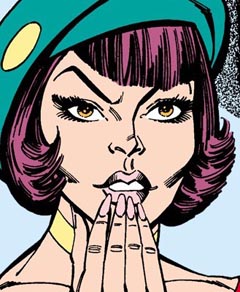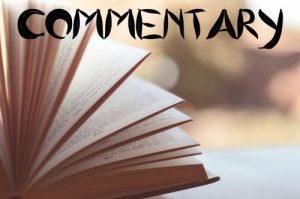The loss of 37 years’ worth of “Star Wars” Expanded Universe continuity gets talked about a lot as the saddest element of Disney’s takeover for us old-school fans of the galaxy far, far away. But one could argue that the saga can recover from the reboot: Give Disney and its continuity editors — the Lucasfilm Story Group – another 37 years and they could create an equally good story, propelled from the ground floor by proven talents like John Jackson Miller, James Luceno, Dave Filoni and Lawrence Kasdan. If you lost your “Star Wars” action figure collection in a fire, you could eventually reassemble an equally good collection.
The more I think about it, though, the loss of the continuity and planets and species and galactic organizations and Jedi history and family trees aren’t the most painful losses. The most painful loss to me is the nixing of “Star Wars” words (“turbolift,” “refresher,” “transparisteel,” etc.). When I read John Jackson Miller’s “A New Dawn” (2014) – the first Disney/LSG novel — I tried to keep an open mind to the new continuity that tied in with “Rebels,” and I mostly was able to do that. It was the absence of “Star Wars” words (now replaced with “elevator,” “bathroom” and “window”) that struck me in the same way the destruction of Alderaan struck Obi-Wan. It was like watching a “Star Wars” movie or TV episode without John Williams’ or Kevin Kiner’s music.
The American English words were intended to keep the theoretical new fan engaged. But they jarred me – a proven, obsessive “Star Wars” fan since 1985 — out of the story.
Over the course of 37 years, the GFFA gradually figured out the right balance between Earth terms and sci-fi terms so that the universe was relatable yet exotic (a balance that all great sci-fi sagas strive for). Through an early process of trial and error from the 1970s through the mid-1990s (what we now know as “Basic” was called “Standard” as recently as “The Truce at Bakura” in 1994), followed by more uniform rules from the Lucasfilm continuity editors from the late 1990s through the 2014 cancellation of the EU, we saw the canonization of delicious “Star Wars” words like those mentioned above. Other tasty examples include “tunic” (shirt), “flimsiplast” (paper), “caf” (coffee), “tapcafe” (a café that serves higher-end ale and caf), “ryshcate” (a sweet Corellian cake), “holoprojector” (3-D TV), “credits” (dollars), “praxeum” (elite academy), “datapad” (computer), “datacard” (flash drive), “sanisteam” (shower), “glowrod” (flashlight), “lekku” (Twi’lek head tails), “skifter” (an illegal playing card), “slicer” (hacker), “stuncuffs” (electric handcuffs) and “vibroblade” (vibrating knife).
While I included the translations (or closest Earth equivalents) in the paragraph above, I didn’t need the translations when reading “Star Wars” books. Context clues and repetition of the terms were more than enough for me to learn the “language” without being consciously aware I was doing so. It’s similar to how a child learns a language through the fun of discovering the world.

It should also be noted that the invention of “Star Wars” words isn’t something the book and comics authors took upon themselves. Rather, they were drawing from George Lucas’ example in the films. Indeed, “comlink” (cell phone), “blaster” (laser gun), “cantina” (bar), “droid” (robot), “binders” (handcuffs) and “Padawan” (Jedi apprentice) are still present in the LSG stories because those terms were spoken in the films, which of course remained canonical after the Disney takeover (as did “The Clone Wars” TV series, even though Disney canceled it).
(Interestingly, “A New Dawn” also retains “slicer,” which isn’t used in the films or TV series. But it also uses “lift” instead of “elevator” in just one instance, making me think those were oversights as the line editors adjusted to the new mandate. At any rate, a mishmash of “Star Wars” and Earth terms isn’t much less distracting than using all Earth terms. This interview with Miller is the only article I could find that directly addresses the thought processes of the LSG regarding “Star Wars” terminology, although Miller is just guessing at how the editors came to their decisions. We’re not likely to get any insight from the formerly great Star Wars Insider, either, as that magazine has embraced the revisionist history that the Expanded Universe is just a massive “What If” tale. The magazine doesn’t ignore the EU’s existence, but it has become a decidedly pro-Disney PR rag now, as one would expect from a licensed mag.)
Disney’s mandate to use American English words rather than sci-fi words is distracting. But it actually gets worse than that, on two levels.
First, the embracing of Earth terms over GFFA terms makes “Star Wars” feel too much like Earth. From what I hear, “Aftermath” – the first Disney novel set between Episodes VI and VII – has shined a glaring light on this pitfall as it uses distinctly 21st century Earth words and phrases such as “trending” and “true dat.” “Star Wars” has always drawn from historical and current Earth events (“So this is how liberty dies. With thunderous applause”), but using modern slang undermines the value of parable. It overemphasizes the familiar while obliterating the exotic.
Second, the strict rules about not using “Star Wars” words means that no new “Star Wars” words can be invented. This isn’t a problem when words are synonyms, like “tunic” and “shirt” – aside from some of the life being sucked out of the universe for persnickety old-school fans, as I noted above. But it severely limits an author’s creativity when he or she is trying to be creative in inventing, for example, an alien culture – and this impacts all fans, not just curmudgeonly fans like me.
The EU’s “New Jedi Order” introduced the extragalactic Yuuzhan Vong, who used organic analogs in place of machine and computer technology. The authors of the Vong saga gave us wonderfully evocative terms like “dovin basal” (mini gravity well projector), “yammosk” (war coordinator of hive-mind-linked ships), “ooglith masquer” (sheath disguise), “villip” (communication screen), “blorash jelly” (a binding substance), “amphistaff” (a weapon that can alternate between staff and whip) and “vunduun crab armor” (living battle armor).
Again, from context clues and outright descriptions in the books, I had no problem figuring out these new “Star Wars” words. A Disney “Star Wars” author, in addition to being discouraged from using sci-fi words, will subconsciously be discouraged from expanding the Disney “Star Wars” universe with new races, cultures, technologies and ways of life.
“A New Dawn” is almost as smart as any previous John Jackson Miller story, but it feels emptier, partly because he couldn’t draw upon the EU continuity (or because he was instructed to change it, notably with Depa Billaba’s new, blander backstory) but just as significantly because he couldn’t use “Star Wars” words.
I’ve heard similar observations about James Luceno’s “Tarkin” (2014), the second book of the Disney continuity. Luceno’s “Darth Plagueis,” which told Darth Sidious’ backstory and drew upon the EU (as Luceno always did, masterfully) was 379 pages long. “Tarkin,” rather than tying together all of Tarkin’s intriguing EU threads (for example, his relationship with Daala and his enslavement of Ackbar), could only draw from his appearances in “The Clone Wars” and “A New Hope.” Not surprisingly, it clocked in at just 274 pages.
The page counts of Luceno’s pre- and post-Disney books suggest that about 25 percent of what used to make “Star Wars” great is now gone. And it will never return as long as Disney thinks the average fan is too dumb or lazy to handle it.
Still, the new timeline is not automatically better or worse than the old one; it is just different, and 37 years from now we can compare the two to see which is better. But the censorship of the language almost guarantees that Disney’s “Star Wars” will be worse.

